Page 450 of 705
449 Controls in detail
Loading and storing
�
Opening storage tray/telephone
compartment: Press button1 and
swing armrest to left or right side.
�
Opening storage compartment:
Press button2 and swing center arm-
rest upward.
Storage compartments below the front
seats
�
Opening: Pull tab1 upward and fold
cover2 forward.Eyeglasses compartment
�
Opening: Press mark1.
�
Closing: Swing eyeglasses compart-
ment upward until it engages.
Parcel net in front passenger footwellA small convenience parcel net is located
in the front passenger footwell. It is for
small and light items, such as road maps,
mail, etc.Warning!
G
The parcel net is intended for storing
light-weight items only.
Heavy objects, objects with sharp edges or
fragile objects may not be transported in the
parcel net. In an accident, during hard
braking, or sudden maneuvers, they could
be injury to vehicle occupants.
The parcel net cannot protect transported
goods in the event of an accident.
Page 452 of 705
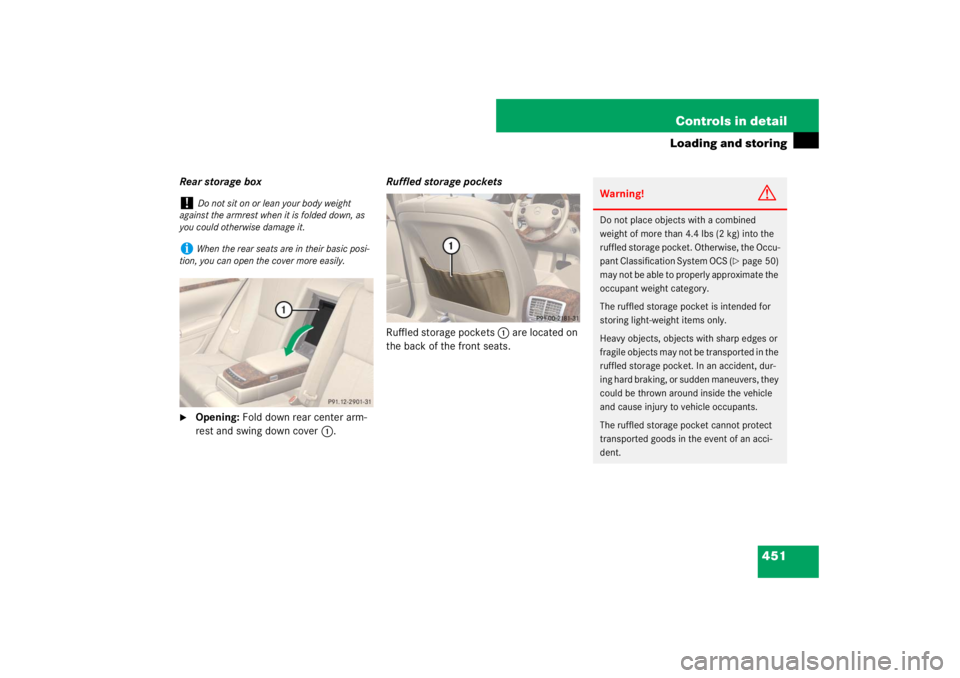
451 Controls in detail
Loading and storing
Rear storage box�
Opening: Fold down rear center arm-
rest and swing down cover1.Ruffled storage pockets
Ruffled storage pockets 1 are located on
the back of the front seats.
!
Do not sit on or lean your body weight
against the armrest when it is folded down, as
you could otherwise damage it.
i
When the rear seats are in their basic posi-
tion, you can open the cover more easily.
Warning!
G
Do not place objects with a combined
weight of more than 4.4 lbs (2 kg) into the
ruffled storage pocket. Otherwise, the Occu-
pant Classification System OCS (
�page 50)
may not be able to properly approximate the
occupant weight category.
The ruffled storage pocket is intended for
storing light-weight items only.
Heavy objects, objects with sharp edges or
fragile objects may not be transported in the
ruffled storage pocket. In an accident, dur-
i n g h a r d b r a k i n g , o r s u d d e n m a n e u v e r s , t h e y
could be thrown around inside the vehicle
and cause injury to vehicle occupants.
The ruffled storage pocket cannot protect
transported goods in the event of an acci-
dent.
Page 458 of 705
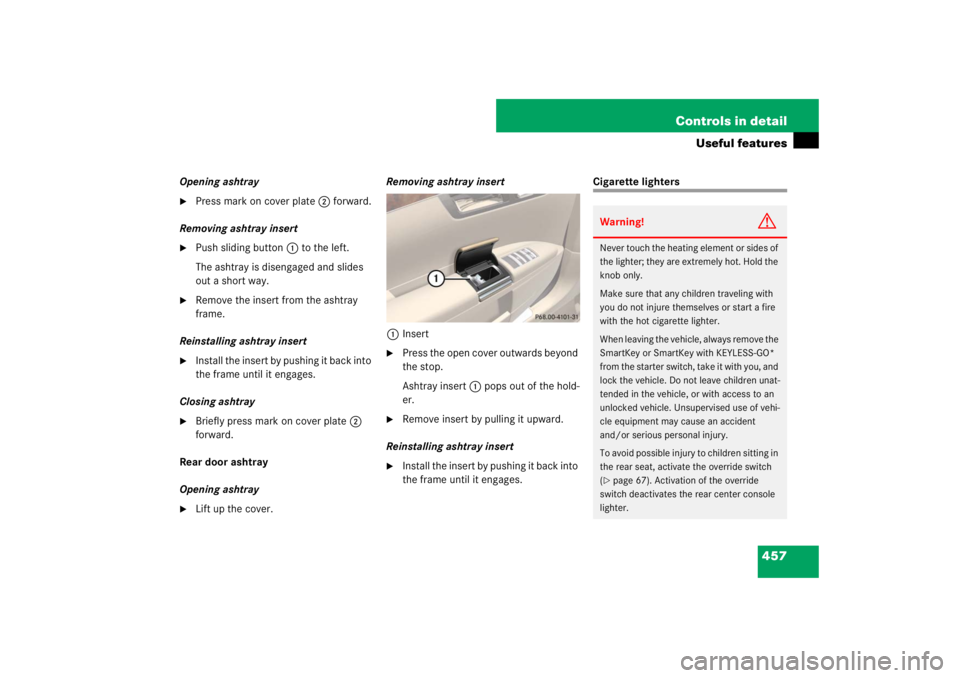
457 Controls in detail
Useful features
Opening ashtray�
Press mark on cover plate2 forward.
Removing ashtray insert
�
Push sliding button1 to the left.
The ashtray is disengaged and slides
out a short way.
�
Remove the insert from the ashtray
frame.
Reinstalling ashtray insert
�
Install the insert by pushing it back into
the frame until it engages.
Closing ashtray
�
Briefly press mark on cover plate2
forward.
Rear door ashtray
Opening ashtray
�
Lift up the cover.Removing ashtray insert
1Insert
�
Press the open cover outwards beyond
the stop.
Ashtray insert1 pops out of the hold-
er.
�
Remove insert by pulling it upward.
Reinstalling ashtray insert
�
Install the insert by pushing it back into
the frame until it engages.
Cigarette lightersWarning!
G
Never touch the heating element or sides of
the lighter; they are extremely hot. Hold the
knob only.
Make sure that any children traveling with
you do not injure themselves or start a fire
with the hot cigarette lighter.
When leaving the vehicle, always remove the
SmartKey or SmartKey with KEYLESS-GO*
from the starter switch, take it with you, and
lock the vehicle. Do not leave children unat-
tended in the vehicle, or with access to an
unlocked vehicle. Unsupervised use of vehi-
cle equipment may cause an accident
and/or serious personal injury.
To avoid possible injury to children sitting in
the rear seat, activate the override switch
(�page 67). Activation of the override
switch deactivates the rear center console
lighter.
Page 486 of 705
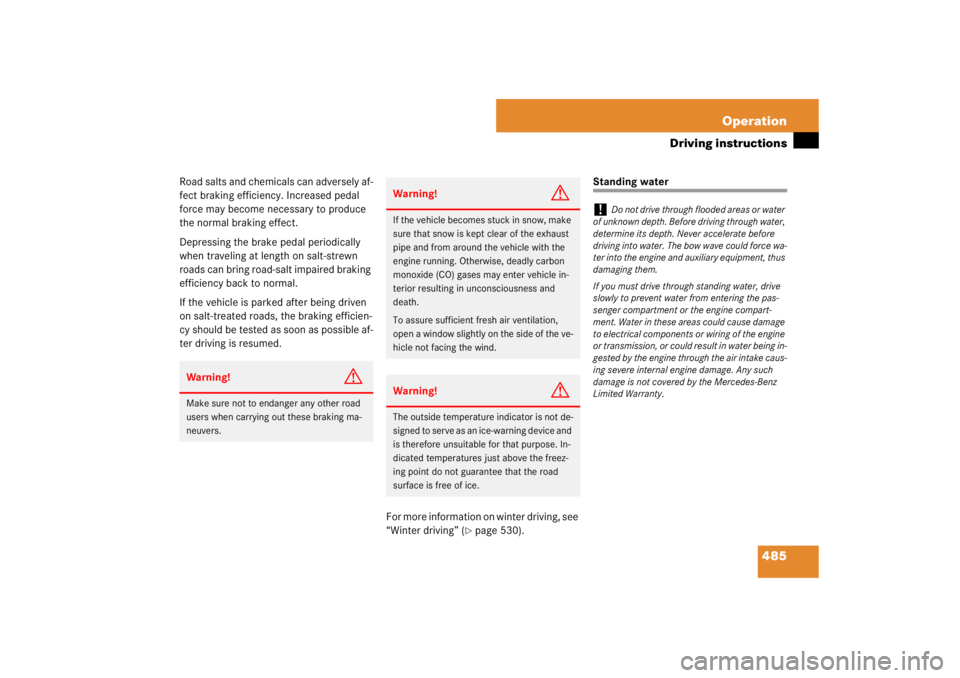
485 Operation
Driving instructions
Road salts and chemicals can adversely af-
fect braking efficiency. Increased pedal
force may become necessary to produce
the normal braking effect.
Depressing the brake pedal periodically
when traveling at length on salt-strewn
roads can bring road-salt impaired braking
efficiency back to normal.
If the vehicle is parked after being driven
on salt-treated roads, the braking efficien-
cy should be tested as soon as possible af-
ter driving is resumed.
For more information on winter driving, see
“Winter driving” (
�page 530).
Standing water
Warning!
G
Make sure not to endanger any other road
users when carrying out these braking ma-
neuvers.
Warning!
G
If the vehicle becomes stuck in snow, make
sure that snow is kept clear of the exhaust
pipe and from around the vehicle with the
engine running. Otherwise, deadly carbon
monoxide (CO) gases may enter vehicle in-
terior resulting in unconsciousness and
death.
To assure sufficient fresh air ventilation,
open a window slightly on the side of the ve-
hicle not facing the wind.Warning!
G
The outside temperature indicator is not de-
signed to serve as an ice-warning device and
is therefore unsuitable for that purpose. In-
dicated temperatures just above the freez-
ing point do not guarantee that the road
surface is free of ice.
!
Do not drive through flooded areas or water
of unknown depth. Before driving through water,
determine its depth. Never accelerate before
driving into water. The bow wave could force wa-
ter into the engine and auxiliary equipment, thus
damaging them.
If you must drive through standing water, drive
slowly to prevent water from entering the pas-
senger compartment or the engine compart-
ment. Water in these areas could cause damage
to electrical components or wiring of the engine
or transmission, or could result in water being in-
gested by the engine through the air intake caus-
ing severe internal engine damage. Any such
damage is not covered by the Mercedes-Benz
Limited Warranty.
Page 493 of 705
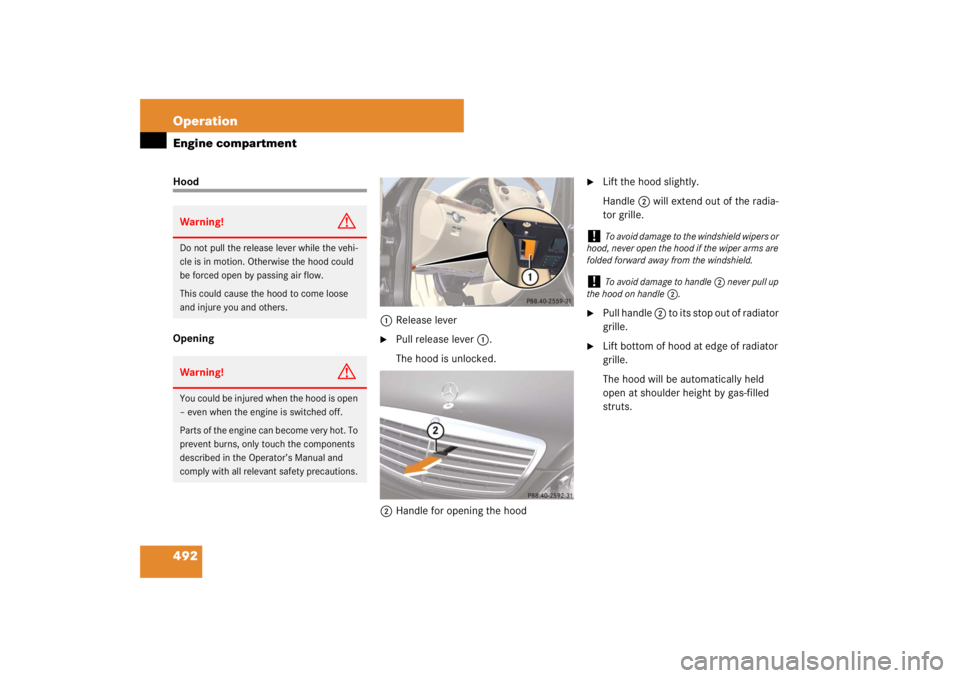
492 OperationEngine compartmentHood
Opening1Release lever
�
Pull release lever 1.
The hood is unlocked.
2Handle for opening the hood
�
Lift the hood slightly.
Handle2 will extend out of the radia-
tor grille.
�
Pull handle 2 to its stop out of radiator
grille.
�
Lift bottom of hood at edge of radiator
grille.
The hood will be automatically held
open at shoulder height by gas-filled
struts.
Warning!
G
Do not pull the release lever while the vehi-
cle is in motion. Otherwise the hood could
be forced open by passing air flow.
This could cause the hood to come loose
and injure you and others.Warning!
G
You could be injured when the hood is open
– even when the engine is switched off.
Parts of the engine can become very hot. To
prevent burns, only touch the components
described in the Operator’s Manual and
comply with all relevant safety precautions.
!
To avoid damage to the windshield wipers or
hood, never open the hood if the wiper arms are
folded forward away from the windshield.
!
To avoid damage to handle2 never pull up
the hood on handle2.
Page 503 of 705
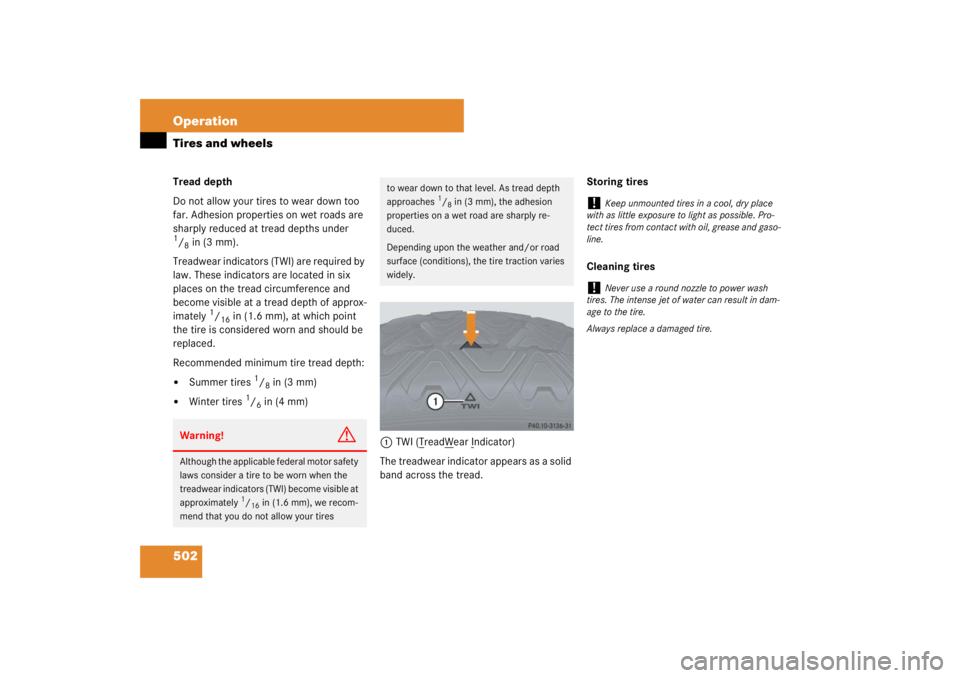
502 OperationTires and wheelsTread depth
Do not allow your tires to wear down too
far. Adhesion properties on wet roads are
sharply reduced at tread depths under 1/8in (3 mm).
Treadwear indicators (TWI) are required by
law. These indicators are located in six
places on the tread circumference and
become visible at a tread depth of approx-
imately
1/16
in (1.6 mm), at which point
the tire is considered worn and should be
replaced.
Recommended minimum tire tread depth:
�
Summer tires
1/8in (3 mm)
�
Winter tires
1/6in (4 mm)
1TWI (T
readW
ear I
ndicator)
The treadwear indicator appears as a solid
band across the tread.Storing tires
Cleaning tires
Warning!
G
Although the applicable federal motor safety
laws consider a tire to be worn when the
treadwear indicators (TWI) become visible at
approximately
1/16in (1.6 mm), we recom-
mend that you do not allow your tires
to wear down to that level. As tread depth
approaches
1/8in (3 mm), the adhesion
properties on a wet road are sharply re-
duced.
Depending upon the weather and/or road
surface (conditions), the tire traction varies
widely.
!
Keep unmounted tires in a cool, dry place
with as little exposure to light as possible. Pro-
tect tires from contact with oil, grease and gaso-
line.
!
Never use a round nozzle to power wash
tires. The intense jet of water can result in dam-
age to the tire.
Always replace a damaged tire.
Page 543 of 705
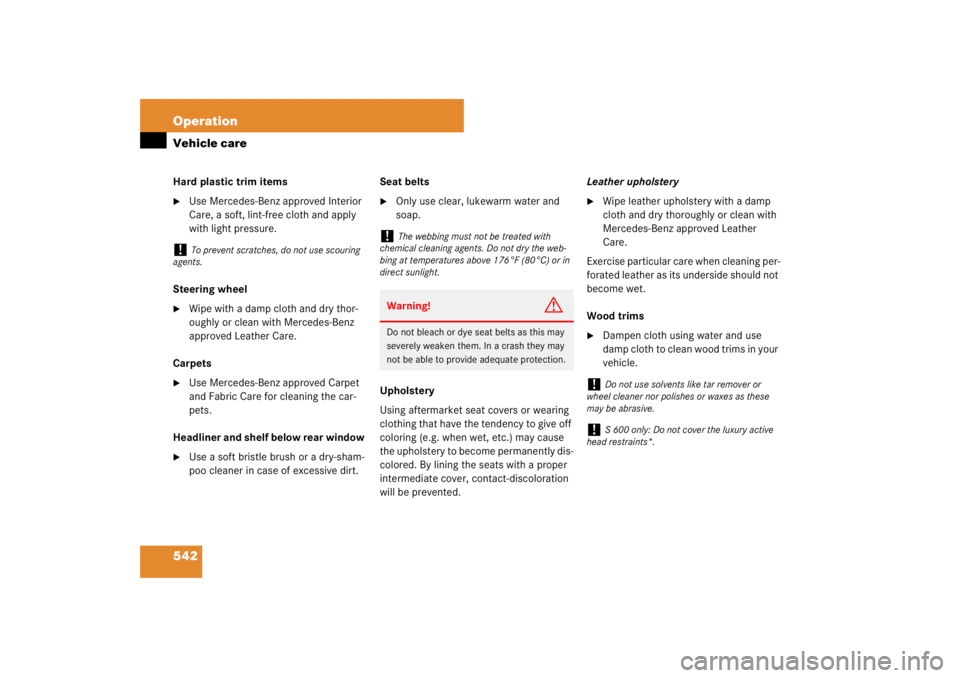
542 OperationVehicle careHard plastic trim items�
Use Mercedes-Benz approved Interior
Care, a soft, lint-free cloth and apply
with light pressure.
Steering wheel
�
Wipe with a damp cloth and dry thor-
oughly or clean with Mercedes-Benz
approved Leather Care.
Carpets
�
Use Mercedes-Benz approved Carpet
and Fabric Care for cleaning the car-
pets.
Headliner and shelf below rear window
�
Use a soft bristle brush or a dry-sham-
poo cleaner in case of excessive dirt. Seat belts
�
Only use clear, lukewarm water and
soap.
Upholstery
Using aftermarket seat covers or wearing
clothing that have the tendency to give off
coloring (e.g. when wet, etc.) may cause
the upholstery to become permanently dis-
colored. By lining the seats with a proper
intermediate cover, contact-discoloration
will be prevented.Leather upholstery
�
Wipe leather upholstery with a damp
cloth and dry thoroughly or clean with
Mercedes-Benz approved Leather
Care.
Exercise particular care when cleaning per-
forated leather as its underside should not
become wet.
Wood trims
�
Dampen cloth using water and use
damp cloth to clean wood trims in your
vehicle.
!
To prevent scratches, do not use scouring
agents.
!
The webbing must not be treated with
chemical cleaning agents. Do not dry the web-
bing at temperatures above 176°F (80°C) or in
direct sunlight.
Warning!
G
Do not bleach or dye seat belts as this may
severely weaken them. In a crash they may
not be able to provide adequate protection.
!
Do not use solvents like tar remover or
wheel cleaner nor polishes or waxes as these
may be abrasive.
!
S 600 only: Do not cover the luxury active
head restraints*.
Page 579 of 705
578 Practical hintsWhat to do if …?Display
Possible cause/consequence
Possible solution
Parking brake
See Oper. Manual
The red indicator lamp for the electric park-
ing brake flashes and the yellow warning
lamp for the electric parking brake lights
up.
The electric parking brake is malfunction-
ing.
�
Switch ignition off and back on again, and en-
gage or release electric parking brake
(�page 364).
or
�
Carefully drive off (
�page 364).
�
Visit an authorized Mercedes-Benz Center as
soon as possible.
or
�
Release electric parking brake mechanically
(�page 616).
�
Visit an authorized Mercedes-Benz Center as
soon as possible.
(USA only)(Canada only)